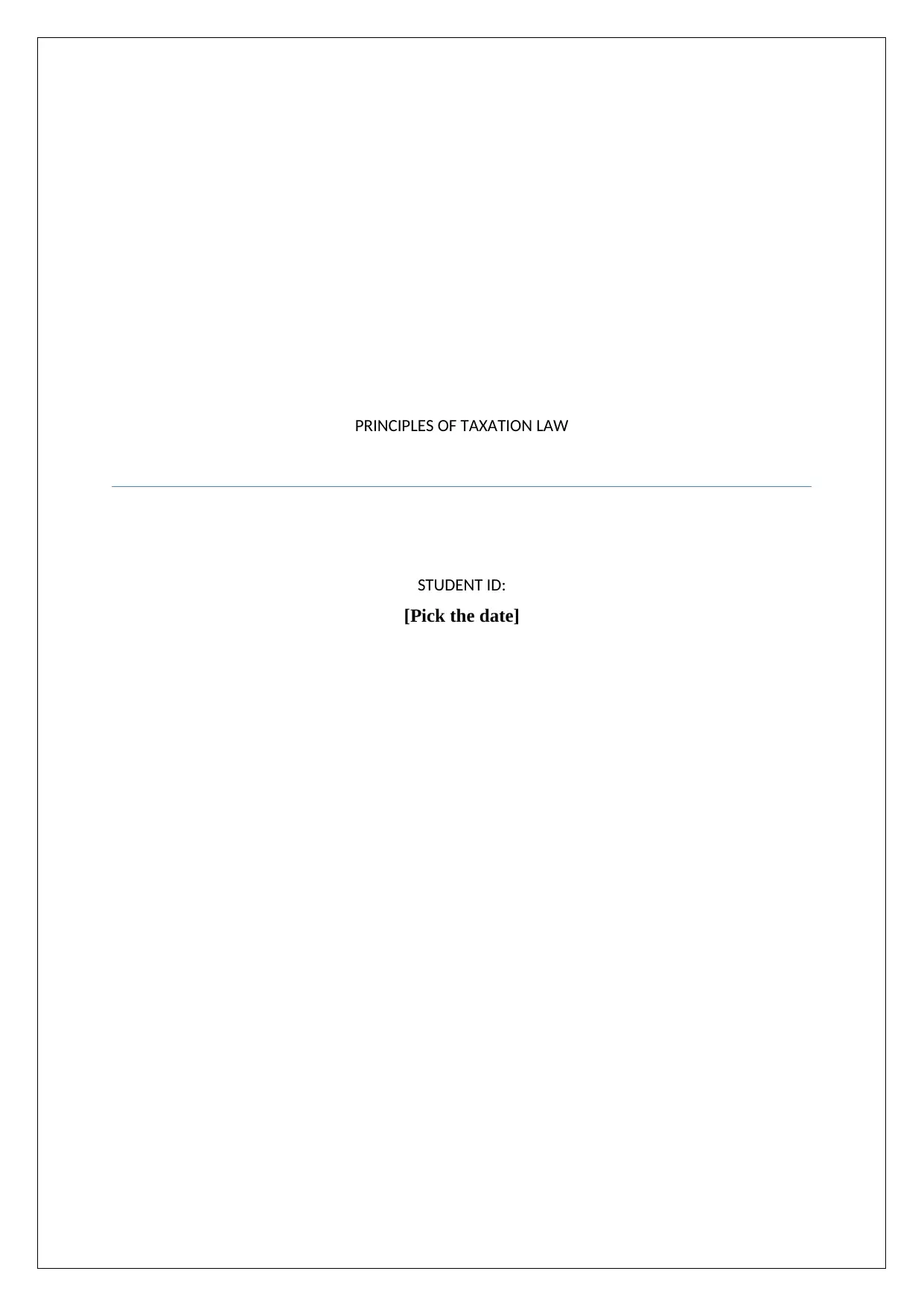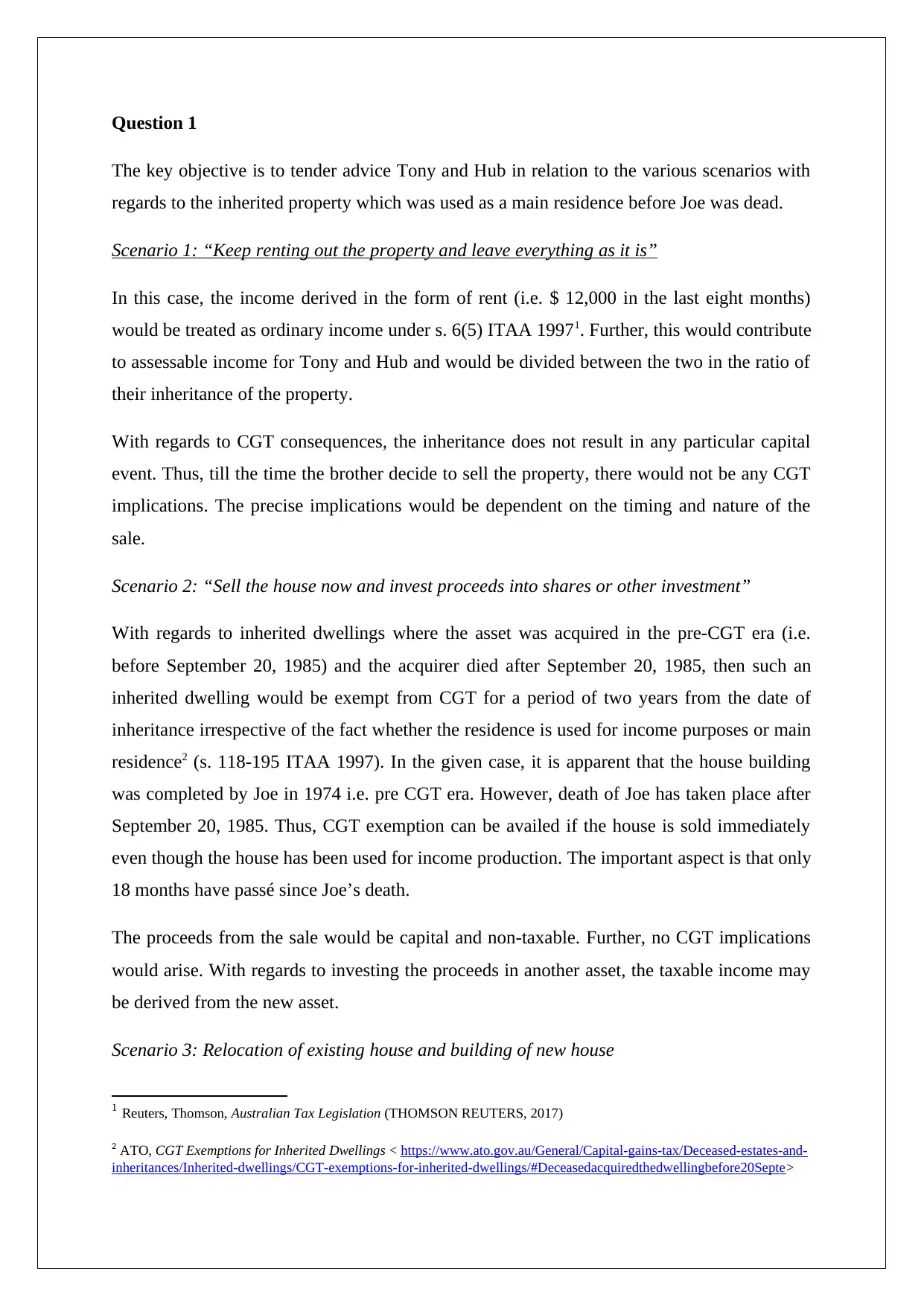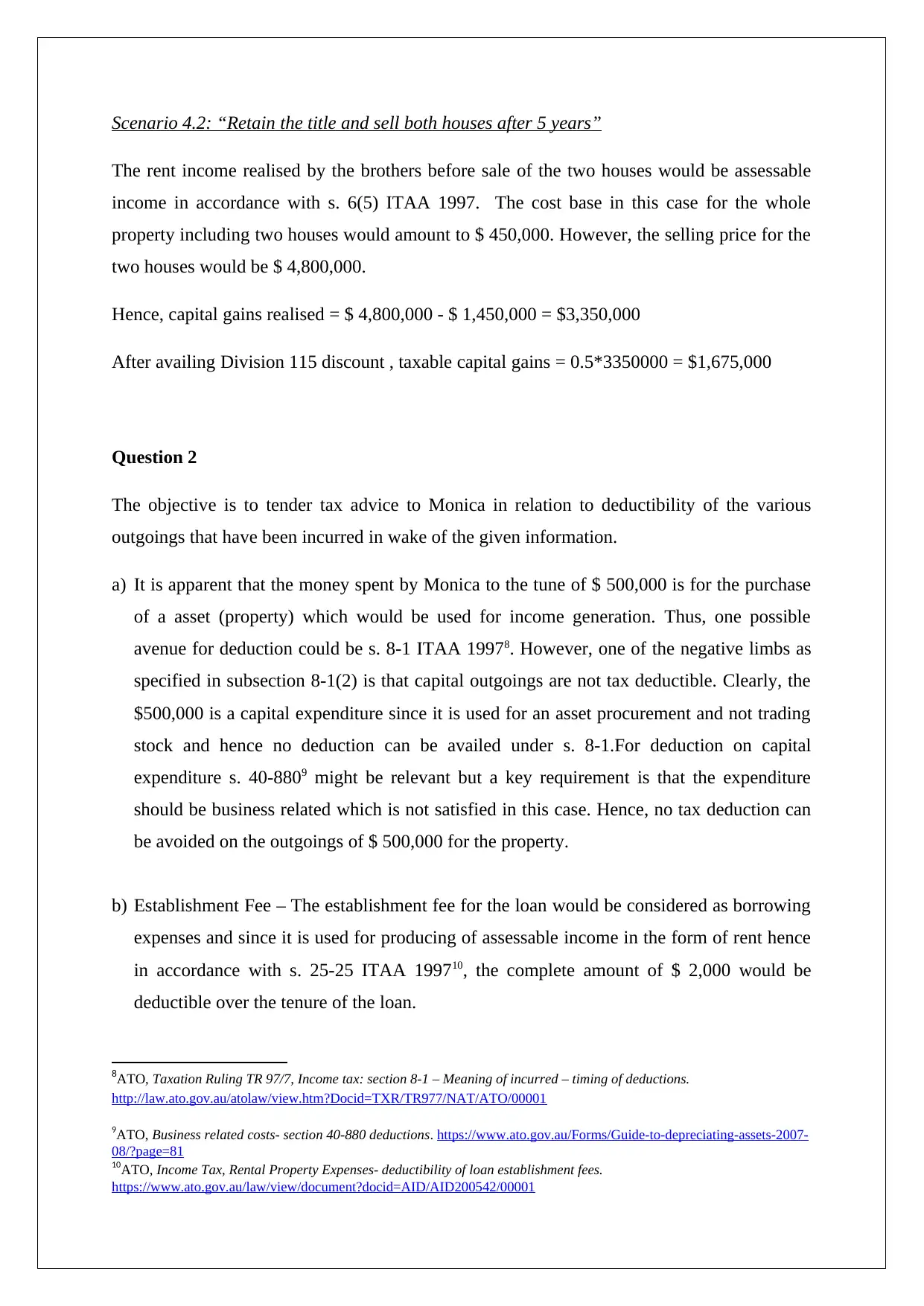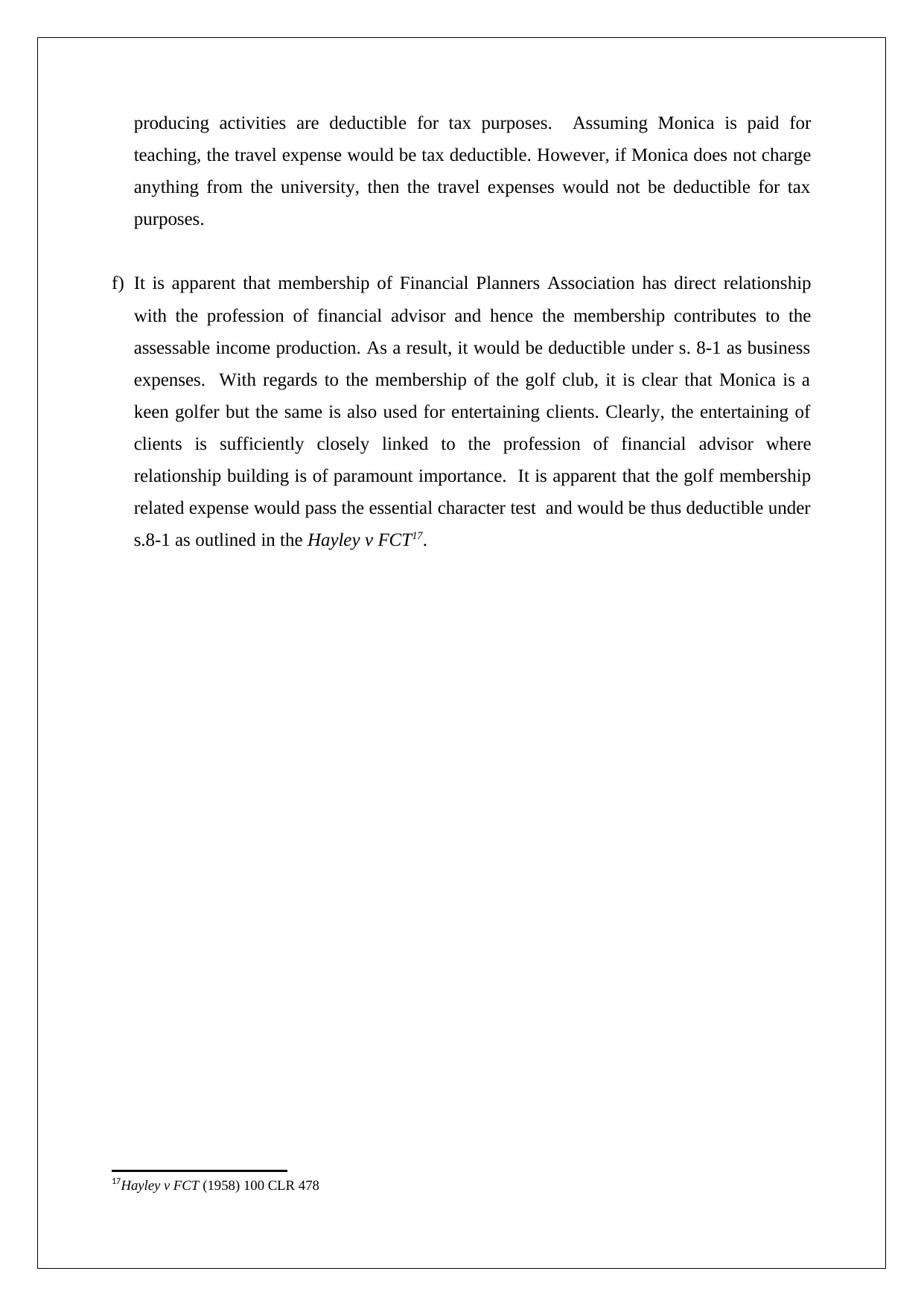Taxation Law: Advice on Inherited Property and Deductibility of Expenses
VerifiedAdded on 2023/06/10
|6
|1966
|474
AI Summary
This article provides expert advice on taxation law related to inherited property and deductibility of expenses. It covers scenarios related to inherited property, CGT implications, deductions for repair and maintenance, and more. The article also discusses the deductibility of various expenses incurred by Monica, including establishment fees, interest and principal, repair and maintenance, doubtful debt, travel expenses, and membership expenses.
Contribute Materials
Your contribution can guide someone’s learning journey. Share your
documents today.

PRINCIPLES OF TAXATION LAW
STUDENT ID:
[Pick the date]
STUDENT ID:
[Pick the date]
Secure Best Marks with AI Grader
Need help grading? Try our AI Grader for instant feedback on your assignments.

Question 1
The key objective is to tender advice Tony and Hub in relation to the various scenarios with
regards to the inherited property which was used as a main residence before Joe was dead.
Scenario 1: “Keep renting out the property and leave everything as it is”
In this case, the income derived in the form of rent (i.e. $ 12,000 in the last eight months)
would be treated as ordinary income under s. 6(5) ITAA 19971. Further, this would contribute
to assessable income for Tony and Hub and would be divided between the two in the ratio of
their inheritance of the property.
With regards to CGT consequences, the inheritance does not result in any particular capital
event. Thus, till the time the brother decide to sell the property, there would not be any CGT
implications. The precise implications would be dependent on the timing and nature of the
sale.
Scenario 2: “Sell the house now and invest proceeds into shares or other investment”
With regards to inherited dwellings where the asset was acquired in the pre-CGT era (i.e.
before September 20, 1985) and the acquirer died after September 20, 1985, then such an
inherited dwelling would be exempt from CGT for a period of two years from the date of
inheritance irrespective of the fact whether the residence is used for income purposes or main
residence2 (s. 118-195 ITAA 1997). In the given case, it is apparent that the house building
was completed by Joe in 1974 i.e. pre CGT era. However, death of Joe has taken place after
September 20, 1985. Thus, CGT exemption can be availed if the house is sold immediately
even though the house has been used for income production. The important aspect is that only
18 months have passé since Joe’s death.
The proceeds from the sale would be capital and non-taxable. Further, no CGT implications
would arise. With regards to investing the proceeds in another asset, the taxable income may
be derived from the new asset.
Scenario 3: Relocation of existing house and building of new house
1 Reuters, Thomson, Australian Tax Legislation (THOMSON REUTERS, 2017)
2 ATO, CGT Exemptions for Inherited Dwellings < https://www.ato.gov.au/General/Capital-gains-tax/Deceased-estates-and-
inheritances/Inherited-dwellings/CGT-exemptions-for-inherited-dwellings/#Deceasedacquiredthedwellingbefore20Septe>
The key objective is to tender advice Tony and Hub in relation to the various scenarios with
regards to the inherited property which was used as a main residence before Joe was dead.
Scenario 1: “Keep renting out the property and leave everything as it is”
In this case, the income derived in the form of rent (i.e. $ 12,000 in the last eight months)
would be treated as ordinary income under s. 6(5) ITAA 19971. Further, this would contribute
to assessable income for Tony and Hub and would be divided between the two in the ratio of
their inheritance of the property.
With regards to CGT consequences, the inheritance does not result in any particular capital
event. Thus, till the time the brother decide to sell the property, there would not be any CGT
implications. The precise implications would be dependent on the timing and nature of the
sale.
Scenario 2: “Sell the house now and invest proceeds into shares or other investment”
With regards to inherited dwellings where the asset was acquired in the pre-CGT era (i.e.
before September 20, 1985) and the acquirer died after September 20, 1985, then such an
inherited dwelling would be exempt from CGT for a period of two years from the date of
inheritance irrespective of the fact whether the residence is used for income purposes or main
residence2 (s. 118-195 ITAA 1997). In the given case, it is apparent that the house building
was completed by Joe in 1974 i.e. pre CGT era. However, death of Joe has taken place after
September 20, 1985. Thus, CGT exemption can be availed if the house is sold immediately
even though the house has been used for income production. The important aspect is that only
18 months have passé since Joe’s death.
The proceeds from the sale would be capital and non-taxable. Further, no CGT implications
would arise. With regards to investing the proceeds in another asset, the taxable income may
be derived from the new asset.
Scenario 3: Relocation of existing house and building of new house
1 Reuters, Thomson, Australian Tax Legislation (THOMSON REUTERS, 2017)
2 ATO, CGT Exemptions for Inherited Dwellings < https://www.ato.gov.au/General/Capital-gains-tax/Deceased-estates-and-
inheritances/Inherited-dwellings/CGT-exemptions-for-inherited-dwellings/#Deceasedacquiredthedwellingbefore20Septe>

Clearly, since the existing house is being stripped off and then renovated like new, this it
would not be recognised as repairs but instead would be categorised as improvements. This is
in line with the discussion in FCT v Western Suburbs Cinemas Ltd3 case. As a result, the
concerned expenditure would be capital in nature and not revenue. Thus, no deduction under
s.8-1 is available for the $ 200,000 which is not for repairs and hence non-deductible under s.
25-10 ITAA 19974. Further, the new house cost of $ 250,000 along with the improvement
would be added to the capital base of the asset (i.e. property) in line with s. 110-25 ITAA
1997 where any costs incurred to bring significant improvement in the value of the asset are
considered as part of the capital base5.
Hence, the construction of the new house and improvement in the old house has no
implications for income but merely increases the cost base of the property by $ 450,000
which would be reflected when the property would be sold.
Scenario 4.1: “Divide the title and sell both houses”
In this case, there are two assets which need to be treated separately for the purpose of
deriving the CGT. However, since both the assets are being sold hence these can be clubbed
for sake of CGT computation. The cost of acquisition of the inherited property would be $
1,000,000 since this is the market value on the day of Joe’s death6.
Cost of acquisition of property = $ 1,000,000
Cost of improvement of property = $ 450,000
Cost base of the property consisting of two houses = $1,000,000 + $ 450,000 = $ 1,450,000
Sales proceeds = $ 1,200,000*2 = $ 2,400,000
Capital gains realised (if the houses are sold after 2 years from death which is likely
considering 18 months have already passed) = $2,4000,000 - $ 1,450,000 = $ 950,000
Under division 115, 50% discount would be available considering that holding period is more
than a year7. Hence capital gains subject to CGT = 0.5*950,000 = $ 475,000
3 FCT v Western Suburbs Cinemas Ltd (1952) HCA 28
4 Krever Richard, Australian Taxation Law Cases 2017 (THOMSON LAWBOOK Company, 2017)
5 Barkoczy, Stephen, et al, Australian Taxation Law 2017 (Oxford University Press Australia., 27thed, 2017)
6 Ibid. 4
7 Ibid. 5
would not be recognised as repairs but instead would be categorised as improvements. This is
in line with the discussion in FCT v Western Suburbs Cinemas Ltd3 case. As a result, the
concerned expenditure would be capital in nature and not revenue. Thus, no deduction under
s.8-1 is available for the $ 200,000 which is not for repairs and hence non-deductible under s.
25-10 ITAA 19974. Further, the new house cost of $ 250,000 along with the improvement
would be added to the capital base of the asset (i.e. property) in line with s. 110-25 ITAA
1997 where any costs incurred to bring significant improvement in the value of the asset are
considered as part of the capital base5.
Hence, the construction of the new house and improvement in the old house has no
implications for income but merely increases the cost base of the property by $ 450,000
which would be reflected when the property would be sold.
Scenario 4.1: “Divide the title and sell both houses”
In this case, there are two assets which need to be treated separately for the purpose of
deriving the CGT. However, since both the assets are being sold hence these can be clubbed
for sake of CGT computation. The cost of acquisition of the inherited property would be $
1,000,000 since this is the market value on the day of Joe’s death6.
Cost of acquisition of property = $ 1,000,000
Cost of improvement of property = $ 450,000
Cost base of the property consisting of two houses = $1,000,000 + $ 450,000 = $ 1,450,000
Sales proceeds = $ 1,200,000*2 = $ 2,400,000
Capital gains realised (if the houses are sold after 2 years from death which is likely
considering 18 months have already passed) = $2,4000,000 - $ 1,450,000 = $ 950,000
Under division 115, 50% discount would be available considering that holding period is more
than a year7. Hence capital gains subject to CGT = 0.5*950,000 = $ 475,000
3 FCT v Western Suburbs Cinemas Ltd (1952) HCA 28
4 Krever Richard, Australian Taxation Law Cases 2017 (THOMSON LAWBOOK Company, 2017)
5 Barkoczy, Stephen, et al, Australian Taxation Law 2017 (Oxford University Press Australia., 27thed, 2017)
6 Ibid. 4
7 Ibid. 5

Scenario 4.2: “Retain the title and sell both houses after 5 years”
The rent income realised by the brothers before sale of the two houses would be assessable
income in accordance with s. 6(5) ITAA 1997. The cost base in this case for the whole
property including two houses would amount to $ 450,000. However, the selling price for the
two houses would be $ 4,800,000.
Hence, capital gains realised = $ 4,800,000 - $ 1,450,000 = $3,350,000
After availing Division 115 discount , taxable capital gains = 0.5*3350000 = $1,675,000
Question 2
The objective is to tender tax advice to Monica in relation to deductibility of the various
outgoings that have been incurred in wake of the given information.
a) It is apparent that the money spent by Monica to the tune of $ 500,000 is for the purchase
of a asset (property) which would be used for income generation. Thus, one possible
avenue for deduction could be s. 8-1 ITAA 19978. However, one of the negative limbs as
specified in subsection 8-1(2) is that capital outgoings are not tax deductible. Clearly, the
$500,000 is a capital expenditure since it is used for an asset procurement and not trading
stock and hence no deduction can be availed under s. 8-1.For deduction on capital
expenditure s. 40-8809 might be relevant but a key requirement is that the expenditure
should be business related which is not satisfied in this case. Hence, no tax deduction can
be avoided on the outgoings of $ 500,000 for the property.
b) Establishment Fee – The establishment fee for the loan would be considered as borrowing
expenses and since it is used for producing of assessable income in the form of rent hence
in accordance with s. 25-25 ITAA 199710, the complete amount of $ 2,000 would be
deductible over the tenure of the loan.
8ATO, Taxation Ruling TR 97/7, Income tax: section 8-1 – Meaning of incurred – timing of deductions.
http://law.ato.gov.au/atolaw/view.htm?Docid=TXR/TR977/NAT/ATO/00001
9ATO, Business related costs- section 40-880 deductions. https://www.ato.gov.au/Forms/Guide-to-depreciating-assets-2007-
08/?page=81
10ATO, Income Tax, Rental Property Expenses- deductibility of loan establishment fees.
https://www.ato.gov.au/law/view/document?docid=AID/AID200542/00001
The rent income realised by the brothers before sale of the two houses would be assessable
income in accordance with s. 6(5) ITAA 1997. The cost base in this case for the whole
property including two houses would amount to $ 450,000. However, the selling price for the
two houses would be $ 4,800,000.
Hence, capital gains realised = $ 4,800,000 - $ 1,450,000 = $3,350,000
After availing Division 115 discount , taxable capital gains = 0.5*3350000 = $1,675,000
Question 2
The objective is to tender tax advice to Monica in relation to deductibility of the various
outgoings that have been incurred in wake of the given information.
a) It is apparent that the money spent by Monica to the tune of $ 500,000 is for the purchase
of a asset (property) which would be used for income generation. Thus, one possible
avenue for deduction could be s. 8-1 ITAA 19978. However, one of the negative limbs as
specified in subsection 8-1(2) is that capital outgoings are not tax deductible. Clearly, the
$500,000 is a capital expenditure since it is used for an asset procurement and not trading
stock and hence no deduction can be availed under s. 8-1.For deduction on capital
expenditure s. 40-8809 might be relevant but a key requirement is that the expenditure
should be business related which is not satisfied in this case. Hence, no tax deduction can
be avoided on the outgoings of $ 500,000 for the property.
b) Establishment Fee – The establishment fee for the loan would be considered as borrowing
expenses and since it is used for producing of assessable income in the form of rent hence
in accordance with s. 25-25 ITAA 199710, the complete amount of $ 2,000 would be
deductible over the tenure of the loan.
8ATO, Taxation Ruling TR 97/7, Income tax: section 8-1 – Meaning of incurred – timing of deductions.
http://law.ato.gov.au/atolaw/view.htm?Docid=TXR/TR977/NAT/ATO/00001
9ATO, Business related costs- section 40-880 deductions. https://www.ato.gov.au/Forms/Guide-to-depreciating-assets-2007-
08/?page=81
10ATO, Income Tax, Rental Property Expenses- deductibility of loan establishment fees.
https://www.ato.gov.au/law/view/document?docid=AID/AID200542/00001
Secure Best Marks with AI Grader
Need help grading? Try our AI Grader for instant feedback on your assignments.

Interest & Principal –In accordance with decision in the Steele vDCT11, it is apparent that
interest expense related to any asset which would be used to produce assessable income
would be tax deductible. In the given case, Monica has assumed debt for purchase of rental
property and since rent is assessable income under s. 6(5) ITAA 199712, hence interest
expenditure would be deductible. However, the principal repayment would be capital
outgoing and hence not deductible under s. 8-1.
c) Expenditure on repair and maintenance may be completely deductible under s. 25-10
ITAA 199713 in the year of incurring of the expenses when the underlying property is
being used for assessable income production. However, it is noticeable that when the
repairs are done before renting, then these are termed as initial repairs and considered to
be capital expenditure which is non-deductible under s. 25-10. Instead, these are added
into the cost base of the asset i.e. rental property in this case and not available for tax
deduction.
d) In accordance with s. 25-35(1) ITAA 199714, a deduction for a debt categorised as
doubtful debt can be made only if it was included as assessable income either in the
previous year or in the current year. Thus, deduction can be made if Monica adds $ 500 as
ordinary income in the current year tax computations. However, if Monica does not
consider $ 500 as income, then no deduction for doubtful debt can be made.
e) With regards to deductibility of travel expenses, the verdict of the FCT v Payne15is critical
which highlights that the travel expenses incurred by the taxpayer between two unrelated
work places would not be deductible under s.8(1) as the incurred travel expenses enables
the taxpayer to be in the “position to produce assessable income” but does not lead to
produce of assessable income. Going by this, the $500 expenses on transport between
office and university incurred by Monica do not seem to be tax deductible. However, s.
25-100(1) ITAA 199716 states that any expenses related to travelling between two income
11Steele v DCT (1999) HCA 7
12ATO, Income Tax. Assessability of an Australian sourced interest income received by a Sri Lankan resident.
http://law.ato.gov.au/atolaw/view.htm?docid=AID/AID200723/00001
13ATO, Taxation Ruling, TR 97/23. Income tax : deductions for repairs. https://www.ato.gov.au/law/view/document?
docid=TXR/TR9723/nat/ato/00001
14 ATO, ATO Interpretative Decision, Deductions and expenses: Bad Debt (Loan by beneficiary to truat.
https://www.ato.gov.au/law/view/document?docid=AID/AID2001301/00001
15FCT v Payne (2001) 46 ATR 228
16Barkoczy Stephen, Core Tax Legislation and Study Guide 2017 (Oxford University Press Australia, 2017)
interest expense related to any asset which would be used to produce assessable income
would be tax deductible. In the given case, Monica has assumed debt for purchase of rental
property and since rent is assessable income under s. 6(5) ITAA 199712, hence interest
expenditure would be deductible. However, the principal repayment would be capital
outgoing and hence not deductible under s. 8-1.
c) Expenditure on repair and maintenance may be completely deductible under s. 25-10
ITAA 199713 in the year of incurring of the expenses when the underlying property is
being used for assessable income production. However, it is noticeable that when the
repairs are done before renting, then these are termed as initial repairs and considered to
be capital expenditure which is non-deductible under s. 25-10. Instead, these are added
into the cost base of the asset i.e. rental property in this case and not available for tax
deduction.
d) In accordance with s. 25-35(1) ITAA 199714, a deduction for a debt categorised as
doubtful debt can be made only if it was included as assessable income either in the
previous year or in the current year. Thus, deduction can be made if Monica adds $ 500 as
ordinary income in the current year tax computations. However, if Monica does not
consider $ 500 as income, then no deduction for doubtful debt can be made.
e) With regards to deductibility of travel expenses, the verdict of the FCT v Payne15is critical
which highlights that the travel expenses incurred by the taxpayer between two unrelated
work places would not be deductible under s.8(1) as the incurred travel expenses enables
the taxpayer to be in the “position to produce assessable income” but does not lead to
produce of assessable income. Going by this, the $500 expenses on transport between
office and university incurred by Monica do not seem to be tax deductible. However, s.
25-100(1) ITAA 199716 states that any expenses related to travelling between two income
11Steele v DCT (1999) HCA 7
12ATO, Income Tax. Assessability of an Australian sourced interest income received by a Sri Lankan resident.
http://law.ato.gov.au/atolaw/view.htm?docid=AID/AID200723/00001
13ATO, Taxation Ruling, TR 97/23. Income tax : deductions for repairs. https://www.ato.gov.au/law/view/document?
docid=TXR/TR9723/nat/ato/00001
14 ATO, ATO Interpretative Decision, Deductions and expenses: Bad Debt (Loan by beneficiary to truat.
https://www.ato.gov.au/law/view/document?docid=AID/AID2001301/00001
15FCT v Payne (2001) 46 ATR 228
16Barkoczy Stephen, Core Tax Legislation and Study Guide 2017 (Oxford University Press Australia, 2017)

producing activities are deductible for tax purposes. Assuming Monica is paid for
teaching, the travel expense would be tax deductible. However, if Monica does not charge
anything from the university, then the travel expenses would not be deductible for tax
purposes.
f) It is apparent that membership of Financial Planners Association has direct relationship
with the profession of financial advisor and hence the membership contributes to the
assessable income production. As a result, it would be deductible under s. 8-1 as business
expenses. With regards to the membership of the golf club, it is clear that Monica is a
keen golfer but the same is also used for entertaining clients. Clearly, the entertaining of
clients is sufficiently closely linked to the profession of financial advisor where
relationship building is of paramount importance. It is apparent that the golf membership
related expense would pass the essential character test and would be thus deductible under
s.8-1 as outlined in the Hayley v FCT17.
17Hayley v FCT (1958) 100 CLR 478
teaching, the travel expense would be tax deductible. However, if Monica does not charge
anything from the university, then the travel expenses would not be deductible for tax
purposes.
f) It is apparent that membership of Financial Planners Association has direct relationship
with the profession of financial advisor and hence the membership contributes to the
assessable income production. As a result, it would be deductible under s. 8-1 as business
expenses. With regards to the membership of the golf club, it is clear that Monica is a
keen golfer but the same is also used for entertaining clients. Clearly, the entertaining of
clients is sufficiently closely linked to the profession of financial advisor where
relationship building is of paramount importance. It is apparent that the golf membership
related expense would pass the essential character test and would be thus deductible under
s.8-1 as outlined in the Hayley v FCT17.
17Hayley v FCT (1958) 100 CLR 478
1 out of 6
Related Documents
Your All-in-One AI-Powered Toolkit for Academic Success.
+13062052269
info@desklib.com
Available 24*7 on WhatsApp / Email
![[object Object]](/_next/static/media/star-bottom.7253800d.svg)
Unlock your academic potential
© 2024 | Zucol Services PVT LTD | All rights reserved.




